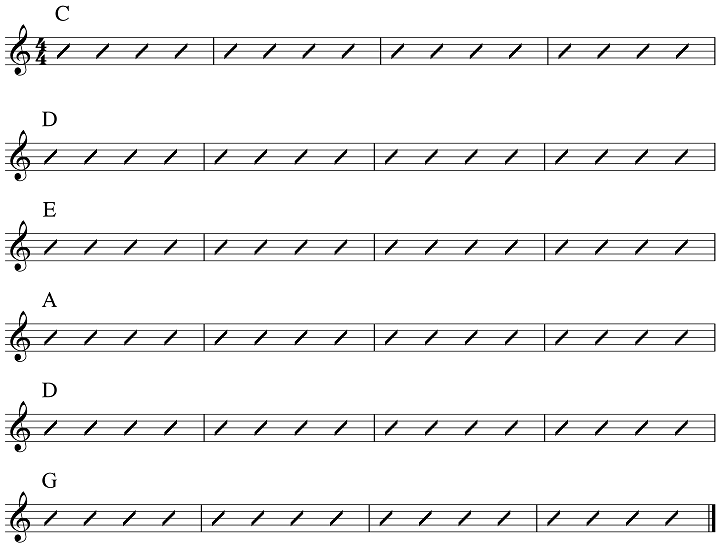Mixolydian Sounds over Major Chords
In today’s lesson, our third look at various ways that you can explore when soloing over Major Chords, we’ll be looking at different sounds that come from the Mixolydian Mode, other wise known as the fifth mode of the major scale.
We will check out triad pairs, arpeggios, pentatonic and major scales, how to build and practice these different melodic ideas as well as how to apply them to your soloing ideas.
The Mixolydian sound is a great way to bring a Blues, Jazz or Country vibe to your major chord soloing ideas, as it is found in many of the classic solos by legendary players in those genres in this context.
So without further ado, let’s dig into soloing over Major Chords using Mixolydian sounds!
Triad Pairs
The first idea we’ll look at is using two 3-note triads to outline the Mixolydian sound over a major chord in your solos.
We’ll be playing major triads from the root and b7 of the chord, so the tonic and one tone lower.
In the key of C, this would mean playing a C and Bb triad over a C chord to give it a Mixolydian sound in your lines.
Here are a few fingerings to get you started with this idea on the fretboard.

Triad Soloing Exercise
Once you have learned one or both of the above triad pair fingerings, put on the backing track at the bottom of this article and practice soloing over those chords using only their related triad shapes.
Start by sticking to the 6th-string root shapes for each triad pair, then move on to the 5th-string root, and finally move between both shapes as you navigate the chord changes on the backing track.
7th Arpeggios
You can also use arpeggios to outline a Mixolydian sound in your major chord soloing lines, in particular the 7th arpeggio.
Built from the first, 3rd, 5th and 7th notes of the Mixolydian Scale, 1-3-5-b7, the 7th arpeggio is a great way to get right to the heart of the Mixolydian sound as you create lines over major chords on the guitar.
Here are a few fingerings to check out to get you started with learning how to play 7th arpeggios on guitar.

Arpeggios Soloing Exercise
Once you have learned one or both of the above 7th arpeggio fingerings, put on the backing track at the bottom of this article and practice soloing over those chords using only their related 7th arpeggio shapes.
Start by sticking to the 6th-string root shapes for each 7th arpeggio, then move on to the 5th-string root, and finally move between both shapes as you navigate the chord changes on the backing track.
Mixolydian Pentatonic Scale
Although not as popular as the other choices in this article, you can also use the Mixolydian Pentatonic Scale to solo over major chords in order to bring that Mixo vibe to your licks and riffs.
Built by taking the Major Pentatonic Scale and raising the 6th by one fret, to form the intervals 1-2-3-5-b7, this is a great way to keep a Pentatonic approach to your soloing ideas, while outlining the Mixo sound at the same time.
Here are two examples of the Mixolydian Pentatonic Scale to help get you started.

Pentatonic Soloing Exercise
Once you have learned one or both of the above Mixolydian Pentatonic Scale fingerings, put on the backing track at the bottom of this article and practice soloing over those chords using only their related Mixolydian Pentatonic Scale shapes.
Start by sticking to the 6th-string root shapes for each Mixolydian Pentatonic Scale, then move on to the 5th-string root, and finally move between both shapes as you navigate the chord changes on the backing track.
Mixolydian Scale
The last approach to bringing a Mixo sound to your major chord soloing ideas is the Mixolydian Scale itself.
The fifth mode of the major scale, the Mixolydian Scale has the interval pattern 1 2 3 4 5 6 b7, allowing it to outline the 7th arpeggio, with the 9th, 11th and 13th thrown in for good measure.
Here are two fingerings for the Mixolydian Scale that you can check out in order to get started with this scale on the fretboard.

Mixolydian Soloing Exercise
Once you have learned one or both of the above Mixolydian Scale fingerings, put on the backing track at the bottom of this article and practice soloing over those chords using only their related Mixolydian Scale shapes.
Start by sticking to the 6th-string root shapes for each Mixolydian Scale, then move on to the 5th-string root, and finally move between both shapes as you navigate the chord changes on the backing track.
Major Triad Backing Track
The following backing track was built for you to use with the above improvisational exercises. Here is the chord progression on that backing track so you can work through a number of different keys when soloing over this track. Have fun!

Do you have any questions or comments about this lesson? Post your thoughts in the comments thread below.
You are at GuitarMasterClass.net
Don't miss today's
free lick. Plus all our lessons are packed with
free content!
This post has been edited by The Professor: Aug 13 2013, 04:10 PM